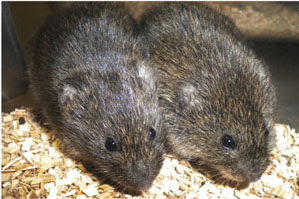We’ve known for some time that many domestic animals, like dogs, can tell us people apart. It turns out that a lot of animal species can recognize individual people. But how do we humans know that? It’s not like you can walk right up to an animal and say “Hey! Remember me?” ...Well, I guess you could do that, but how would you interpret the answer?
Imagine everything that an animal would have to be capable of to be able to recognize different people: the animal would have to be able to discriminate, learn and remember. Those are pretty complex tasks. Despite our stereotypes of molluscs, octopuses (not “octopi”) are actually quite good at all of these things. They are visual animals that can differentiate between abstract shapes, remember visual patterns, and be conditioned (Conditioning is a process by which an animal learns to associate a behavior with some previously unrelated stimulus). Additionally, many people acknowledge octopuses as the most intelligent (and coolest) of all invertebrates. Furthermore, there have been several anecdotal reports of octopuses recognizing individual people. Some octopuses at aquariums consistently approach the keepers that feed them, even when the keeper is in a crowd of other people. One octopus being trained in a lever-pressing task regularly chose to squirt the researcher in the face rather than press the lever. Another octopus apparently only jetted water at a particular night guard. So octopuses seem like a pretty good species to test individual human recognition (and to test for a sense of humor, but that is for another day).
 |
| If you were an octopus, could you tell these two people apart? Photo by Veronica von Allworden from a figure in the paper in The Journal of Applied Animal Welfare Science |
 |
| A giant Pacific octopus displaying his eyebar (shown with the white arrow) in the wild. Photo by Veronica von Allworden from a figure in the paper in The Journal of Applied Animal Welfare Science |
So octopuses can recognize individual humans, and they treat people differently depending on how they have been treated by the humans. …Hmmm… If octopuses can do it, imagine what other species may be able to do it. Meditate on that the next time you interact with an animal.
Now add individual human recognition to other things we know octopuses can do, like learn and remember skills, play with toys, express personalities, and detect things by vision and smell. And they can do this:
and this:
and this:
I mean really, is there anything octopuses can’t do?
Do you want to get to know the octopuses from this study? Learn to recognize them at the Seattle Aquarium or the Seaside Aquarium, where they are now on exhibit.
Want to know more? Check these out:
1. Anderson RC, Mather JA, Monette MQ, & Zimsen SR (2010). Octopuses (Enteroctopus dofleini) recognize individual humans. Journal of applied animal welfare science : JAAWS, 13 (3), 261-72 PMID: 20563906
2. Mather, J.A., Anderson, R.C and Wood, J.B. (2010). Octopus: The Ocean’s Intelligent Invertebrate. Timber Press, Portland, OR.
3. Octopus Chronicles, a Scientific American blog dedicated to everything fascinating and amazing about octopuses
4. AnimalWise, a blog about animal cognition











